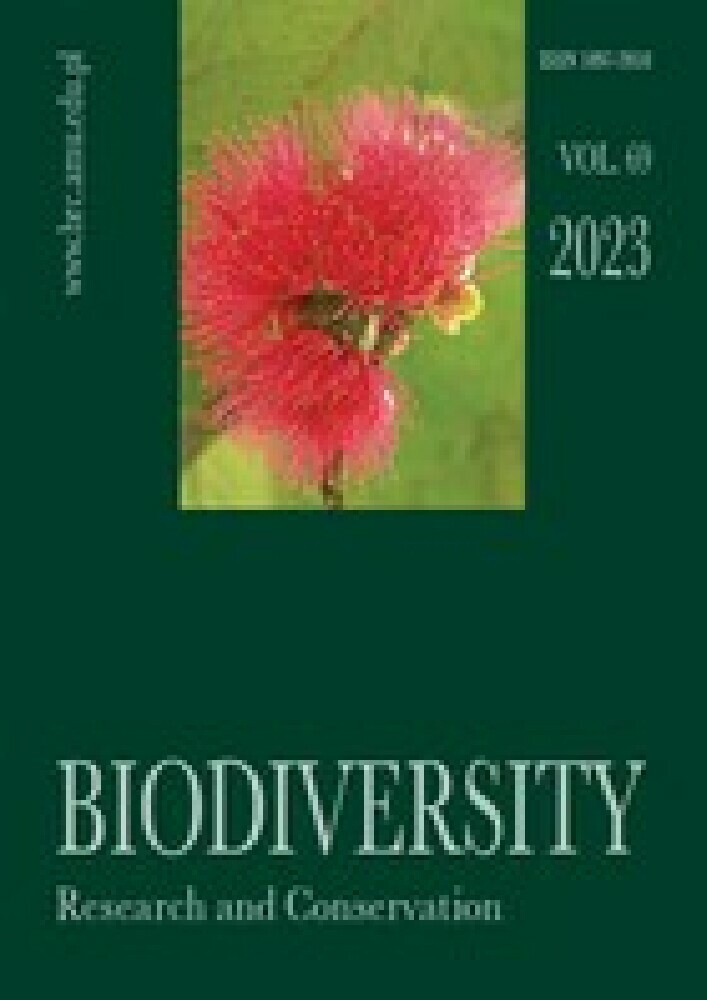Abstract
Although both subspecies of Pteridium aquilinum (subsp. aquilinum and subsp. pinetorum) are widespread in Poland, our knowledge about the occurrence and significance of extrafloral nectaries on frond stipes (petioles) is very limited. Their location on the abaxial stipe surface in pairs at subsequent pinna-bases is often overlooked. The study concerns the morphological/anatomical structure, distribution, and function of the bracken nectaries. Observations of sugar secretions of the nectaries and their local associations with ants indicated a dependence on frond age, seasonality, and environmental factors. The nectaries consist of a single layer of the epidermis with stomata, secretory parenchyma, and ground parenchyma cells lying above the vascular bundles, with a hypodermal sterome composed of fibres. The anatomy of the two examined subspecies revealed a close similarity, despite the morphological differences in size, shape, colour, and secretory activity. This paper provides also a review of published data on the nectaries in P. aquilinum and other fern species.
References
Castrejón-Varela A., Pérez-Garcia B., Guerrero-Analco J. & Mehltreter K. 2022. A brief review of phyto-chemical defences of ferns against herbivores. Am. Fern J. 112(4): 233-250.
Cody W. J. & Crompton C. W. 1975. The biology of Canadian weeds. 15. Pteridium aquilinum. (L.) Kuhn. Can. J. Plant Sci. 55: 1059-1072.
Cooper-Driver G. 1978. Insect fern associations. Entomol. Experiment. Appl. 24: 310-316.
Darwin F. 1877. On the nectar-glands of the common bracken fern Pteris aquilina. J. Linn. Soc. Bot. 15: 407-409.
Essau K. 1965. Plant Anatomy. Wiley & Sons, New York.
Fahn A. 1988. Secretory tissues in vascular plants. New Phytologist 108(3): 229-257.
Fuentes-Jacques L. J., Hanson-Snortum P., Hernandez-Ortiz V., Diaz-Castello C. & Mehltreter K. 2022 A global review and network analysis of phytophagous insect interactions with ferns and lycophytes. Plant Ecol. 223: 27-40.
Heads P. A. & Lawton J. H. 1984. Bracken, ants and extrafloral nectaries. II. The effect of ants on the insect herbivores of bracken. J. Animal Ecol. 53: 1015-1031.
Heads P. A. & Lawton J. H. 1985. Bracken, ants and extrafloral nectaries. III. How insect herbivores avoid ant predation. Ecol. Entomol. 10(1): 29-42.
Heads P. A. 1986. Bracken, ants and extrafloral nectaries. IV. Do wood ants (Formica lugubris) protect the plant against insect herbivores. J. Animal Ecol. 55: 795-809.
Keeler K. H. 2008. World lists of plants with extrafloral nectaries. http://biosci-labs.uni.edu/Emeriti/keeler/extrafloral/Cover.htm.
Lagoria M., Avilla G., Neira D. A., Rodriguez A. M., Rios N. F., Prado J. & Hernandez M. A. 2018. Morphoanatomical and histochemical characteristics of the epititic fern Pleopeltis macrocarpa (Polypodiaceae). Brasil. J. Botany.
Lanan M. 2021. Extrafloral nectaries. In: Encyclopaedia of Social Insects. Springer Verl. 371-375.
Lawton J. H. & Heads P. A. 1984. Bracken, ants and extrafloral nectaries. I. The component of the system. J. Animal Ecol. 53: 995-1014.
Mahley J. N., Pittermann J., Rowe N., Baer A., Watkins J., Schuettpelz E., Wheeler J., Mehltreter K., Widham M., Testo W. & Beck J. 2018. Geometry, allometry and biomechanics of fern leaf petioles: their significance for the evolution of functional and ecological diversity within the Pteridaceae. Front. Plant Sci. 9: 197.
Marrs R. H. & Watt A. S. 2006. Biological flora of the British Isles: Pteridium aquilinum (L.) Kuhn. J. Ecol. 94: 1272-1321.
Mehltreter K., Tenhaken R. & Jansen S. 2022a. Nectaries in ferns: their taxonomic distribution, structure, function, and sugar composition. Am. J. Bot. 109:46-57.
Mehltreter K., Wachter H., Trabi Ch., Testo W., Sundue M. & Jansen S. 2022b. Hydathodes in ferns: their phylogenetic distribution, structure, and function. Ann. Bot. 130(3): 331-344.
Page C. N. 1982. Field observations on the nectaries of bracken (Pteridium aquilinum) in Britain. Fern Gazette 12(4): 233-239.
Page C. N. 1997. The ferns of Britain and Ireland. Cambridge University Press, sec. ed. 344-370.
Power M. S. & Skog J. E. 1987. Ultrastructure of the extrafloral nectaries of Pteridium aquilinum. Am. Fern J. 77: 1-15.
Rumpf S., Cromey M. & Webb C. J. 1994. Ultrastructure and function of the nectaries of New Zealand bracken (Pteridium esculentum (Forst. f.) Cockayne). New Zealand J. Bot. 32(4): 487-496.
Schremmer F. 1969. Extranuptiale nectaries. Beobachtungen in Salix eleagnos Scop. und Pteridium aquilinum (L.) Kuhn. Ost. Bot. Z. 117: 205-222.
Weber M. G. & Keeler K. H. 2012. The phylogenetic distribution of extrafloral nectaries in plants. Ann. Bot. 111: 1251-1261.
White R. A. & Turner M. D. 2012. The anatomy and occurrence of foliar nectaries in Cyathea (Cyatheaceae). Am. Fern J. 102: 91-113.
Wieczorek H. 2009. Zur Kenntnis der Adlerfarninsekten Ein Beitrag zum Problem der biologischen Bekӓmpfung von Pteridium aquilinum (L.) Kuhn in Mitteleuropa. J. Appl. Entomol. 72: 337-358.
Zenkteler E. & Nowak O. 2019. Application of morphometric study to discriminate Pteridium aquilinum (L). Kuhn subsp. aquilinum and subsp. pinetorum (C. N. Page & R. R. Mill 1995) J. A. Thomson in Poland. Biodiv. Res. Conserv. 56: 1-12.
Zenkteler E., Nowak O. & Michalak K. 2022. Characteristic of the indusia and sori in the two subspecies of Pteridium aquilinum (L.) Kuhn occurring in Poland. Biodiv. Res. Conserv. 67: 1-8.
License
Copyright (c) 2023 Elżbieta Zenkteler, Magdalena Ślachetka, Kornel M. Michalak

This work is licensed under a Creative Commons Attribution-NonCommercial-NoDerivatives 3.0 Unported License.





